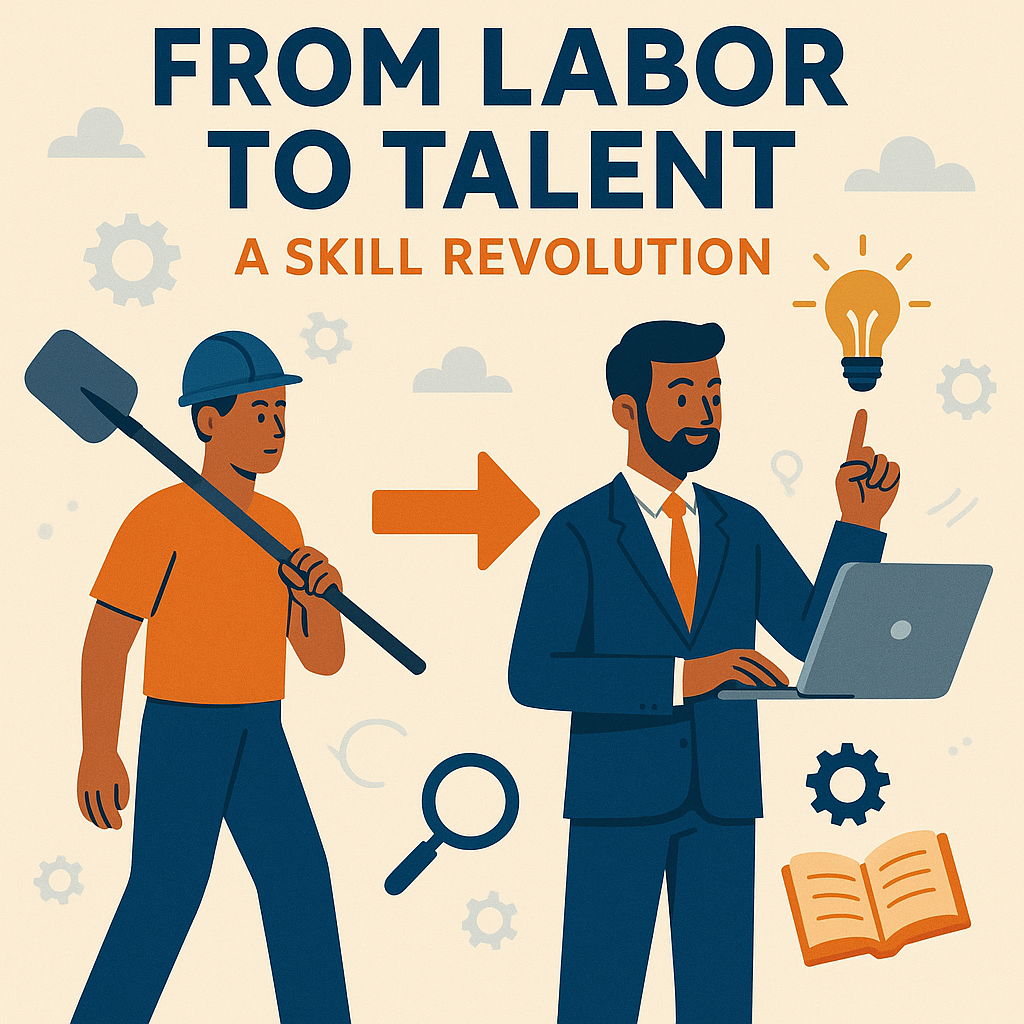Introduction
India’s blue-collar workforce—once defined by manual labor and traditional roles—is undergoing a transformation. As technology permeates factories, warehouses, and service sectors, a new breed of worker is emerging: the digitally skilled blue-collar professional.
Gone are the days when blue-collar jobs meant repetitive, low-skill tasks. Today, sectors like manufacturing, logistics, construction, and automotive demand workers who can operate smart machines, manage software-driven workflows, and adapt to automated systems. This shift marks a significant turning point in India’s industrial story—reshaping hiring, training, wages, and career progression for millions.
The Digital Shift: What’s Driving the Change?
1. Industry 4.0 in Action
From IoT-enabled machines to AI-driven production lines, Industry 4.0 is not a futuristic concept anymore—it’s reality. Manufacturing firms are deploying advanced tech like:
- Programmable logic controllers (PLCs)
- CNC machines
- Robotic arms
- Digital twins
- Predictive maintenance software
This digitization is creating a demand for machine operators, technicians, and maintenance staff who can not only handle tools but also interpret digital dashboards, manage sensor data, and follow safety protocols aligned with real-time analytics.
2. Logistics & E-Commerce Growth
The rapid rise of online shopping has changed the logistics landscape. Companies now rely on:
- Barcode scanning & inventory management software
- Warehouse management systems (WMS)
- Autonomous mobile robots (AMRs)
- Digital delivery apps
Blue-collar roles in logistics now demand tech familiarity—from navigating delivery routes via GPS to updating order statuses on handheld devices.
3. The EV & Smart Mobility Boom
India’s electric vehicle (EV) transition is not just about eco-friendly transport—it’s also about smart assembly lines, battery management systems, and digital diagnostics. EV manufacturing facilities require skilled blue-collar workers trained in electronics, sensors, and programmable tools.
From Labor to Talent: A Skill Revolution

1. Vocational Upskilling
Government-led initiatives like Skill India, PMKVY (Pradhan Mantri Kaushal Vikas Yojana), and SAMARTH Udyog are aligning training modules with modern industry needs. Collaborations with tech firms ensure courses on:
- CAD & CAM software
- Industrial automation
- Basic coding for IoT
- Mechatronics and PLC
Private training institutes and ed-tech platforms like NSDC, Imarticus Learning, and Unnati are also playing a key role.
2. Rise of Multiskilled Workers
Today’s ideal blue-collar worker is:
- Mechanically adept
- Digitally literate
- Safety compliant
- Agile in learning
This hybrid skill set is making workers more valuable, increasing both their employability and bargaining power.
The Employer’s Perspective
1. Retention Through Training
Many forward-thinking employers realize that investing in training equals retention. Companies like Tata Steel, Mahindra, and Maruti Suzuki are setting up in-house training centers focused on digital competence. This reduces errors, boosts morale, and builds internal talent pipelines.
2. Digital HR Tools
Companies are using AI-powered hiring platforms to assess:
- Technical skills via online assessments
- Adaptability via behavioral games
- Digital proficiency via micro-credentialing
Startups like WorkIndia, Apna, and Betterplace are using tech to match skilled blue-collar candidates with jobs more efficiently than ever before.
Wages and Career Growth
1. Premium on Digital Skills
Digitally skilled blue-collar workers now command 15%–25% higher wages than their low-tech peers. For instance:
- A CNC machine operator can earn ₹25,000–35,000/month.
- A logistics worker familiar with SAP or Oracle WMS can earn ₹30,000–40,000/month.
- Skilled maintenance technicians in smart factories command even more.
2. Career Pathways
Unlike earlier when growth was stagnant, today’s digitally trained workers can:
- Get promoted to supervisor, team lead, or technician roles
- Cross over into sales support, quality inspection, or training positions
- Pursue further certifications and shift to white-collar or semi-technical roles
This mobility is vital in giving workers a sense of dignity and long-term vision.
Case Studies
🌟 Maruti Suzuki: Digital Vocational Hubs
Maruti’s Skill Development Centers in Haryana and Gujarat train students in smart manufacturing, offering modules in robotics, AI, and IoT. Most trainees land jobs within three months, and companies report a 20% productivity increase from digitally trained recruits.
🌟 Flipkart Logistics: Tech-First Warehouses
Flipkart uses voice-picking systems, WMS software, and RFID tracking in its warehouses. New recruits are trained in these systems via digital onboarding and simulations, resulting in faster order fulfillment and lower shrinkage.
🌟 Mahindra’s Smart Factory Program
Mahindra has adopted Industry 4.0 technologies across multiple plants. Their Digital Blue-Collar Academy ensures floor operators understand smart sensors, dashboards, and connected tools—leading to a 30% reduction in machine downtime.
Challenges Ahead
Despite progress, hurdles remain:
1. Digital Divide
While urban workers may adapt quickly, rural and Tier-3 workforce segments lack access to digital tools, internet connectivity, or exposure to tech-led environments.
2. Standardization of Training
There’s a wide disparity in training quality across institutions. A national digital certification or rating system for blue-collar skills is urgently needed to bridge employer expectations and trainee abilities.
3. Resistance to Change
Older workers or those from legacy systems may resist new technologies out of fear of redundancy. Change management, incentives, and mentorship are key to helping this demographic transition.
The Road Ahead: Building a Digital-First Workforce
To fully realize the potential of digitally skilled blue-collar talent, India must focus on:
- Public-private partnerships that co-create dynamic skilling curriculums
- Digital literacy campaigns in schools and rural ITIs
- Smart apprenticeships using AR/VR simulations
- Data-driven workforce mapping to identify demand clusters and future skills
Moreover, platforms that celebrate and highlight success stories from the blue-collar sector will help shift societal perceptions and inspire the youth to pursue these tech-powered careers.
Conclusion
The rise of digitally skilled blue-collar workers is not just a labor trend—it’s a social and economic evolution. India’s ability to build a future-ready workforce depends on how inclusively and effectively it bridges the skill gap in this segment.
If manufacturing is the backbone of India’s economy, then its strength will increasingly come not just from machines or capital—but from people who can operate and grow with them in the digital age.
Investing in this segment today means unlocking the productivity, dignity, and resilience of millions tomorrow.




